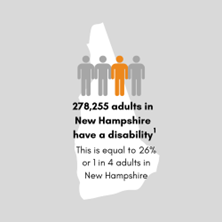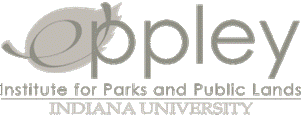The information contained in this article is not intended as legal advice and may no longer be accurate due to changes in the law. Consult NHMA's legal services or your municipal attorney.
Introduction
Accessibility is well known as a requirement for parking, pathways, bathrooms, buildings, and programs. What is lesser known is the benefit accessible design provides to all citizens. The following addresses going beyond the minimum requirements for accessibility to create an inclusive and welcoming community that provides for the current and future needs of its citizens.
A Quick History of Accessibility
In the 1950s, after many veterans returned from World War II and the Korean War with disabilities, the barrier-free movement began. It resulted in national standards for “barrier-free” buildings being set in 1961 and 1968 with the passage of the Architectural Barriers Act, applicable to federally funded buildings. With efforts to establish the rights of individuals with disabilities to live independently, the disability rights movement had a major victory with the passage of Section 504 of the 1973 Rehabilitation Act. Section 504 prohibited discrimination based on disability in access to employment, education, and society. In 1990, the Americans with Disabilities Act (ADA) became law. The ADA prohibits discrimination based on disability in five areas: (Title 1) employment, (Title 2) state and local government, (Title 3) public accommodations and services operated by private entities, (Title 4) telecommunications, and (Title 5) miscellaneous provisions. The ADA required the US Access Board to establish minimum guidelines for new construction and alterations to existing facilities. These minimum guidelines, the 2010 ADA Standards for Accessible Design establish a good reference point for state and local governments that make changes to existing facilities (US DOJ, 2010).
 Image of an unmaintained beach mat resulting in an inaccessible route.
Image of an unmaintained beach mat resulting in an inaccessible route.
Photo Credit: Colleen Durkin-Blackburn, Senior Program Manager, Eppley Institute. 2022.
Going Beyond the Minimum Standards for Design
By 1994, 53.9 million people in the US (20.6% of the population) had some level of disability (McNeil, 1997). In New Hampshire, the Centers for Disease Control and Prevention determined that 26% of adults have a disability, higher than the national average. The principles of universal design are an important step in designing physical spaces and programs for all individuals. When considering renovations or new construction to both interior and exterior spaces, such as parks, libraries, or public pools; it’s important to design for universal use and ensure that all individuals can access and use these community services and resources.

Universal design should be implemented early in the planning process and included as part of the funding considerations. According to the Center for Excellence in Universal Design, it is defined as:
“1. The design and composition of an environment so that it may be accessed, understood, and used i. To the greatest possible extent, ii. In the most independent and natural manner possible, iii. In the widest possible range of situations, iv. Without the need for adaptation, modification, assistive devices, or specialized solutions, by any person of any age or size or having any particular physical, sensory, mental health, or intellectual ability or disability, and 2. Means, in relation to electronic systems, any electronics-based process of creating products, services, or systems so that they may be used by any person.”
Universal design has a degree of benefit to all individuals using a space or product, because ability is a continuum and can change for an individual over time and space. Additionally, life expectancy and survival from illness and injury have both greatly increased in the past 100 years, which results in a larger population of people with disabilities, only expected to increase in the future. Universal design can also boost public image and increase market reach of a product or place (Center for Excellence in Universal Design & Institute for Human Centered Design).
Next Steps: Fostering Inclusion & Belonging
While the ADA standards provide for minimum access, they do not address inclusion or belonging – goals that all public and private entities should aim for. What’s the difference? According to Jeffrey Howard of www.inclusion.hub and www.youth.gov, the difference is summarized as follows:
Accessibility - means that no one is prevented from using a particular product, place or service based on ability.
Inclusion - goes a step further to ensure that not only do all individuals have access, but they also have clear opportunities to contribute and participate in similar ways as their peers. This could include removing barriers to engagement and ensuring representation.
Belonging - means that all individuals have a sense of acceptance, support, and social bonding. In other words, they are an integral part of the community rather than being prevented from full inclusion or simply being tolerated.
With these summaries in mind, how can our communities begin to foster inclusion and a sense of belonging for our citizens with disabilities? A great first step is the use of person-first language. Person-first language puts emphasis on the person rather than a disability using terminology such as “a person who…” or “a person with…” (youth.gov). While some people with disabilities prefer identity first language (Disabled person, Autistic person, Deaf person), person first language as a default is accepted by most people with disabilities, especially in shorter interactions.
However, with any inclusion work, be it universal design, changing your language, or anything else, it’s important to recognize that it is a process, and a way of thinking. A single change, or meeting the standards, is not inclusion, nor is developing your next project with the principles of universal design focused on one disability. Making the effort to think about and incorporate inclusive practices from the beginning of a project, to analyzing it after, and every place in between, is the best way to ensure that your spaces are inclusive and welcoming for all.
Colleen Durkin-Blackburn is the Senior Program Manager of Accessibility and Park Planning at The Eppley Institute of Parks and Public Lands within the Indiana Institute on Disability and Community at Indiana University. She can be reached by email at cadurkin@iu.edu or through The Eppley Institute website at: eppley.org
Source: Centers for Disease Control and Prevention. Disability & Health US state profile data for New Hampshire (Adults 18+ years of age). (Reviewed May 12, 2023). Retrieved July 30, 2023 from: Disability & Health U.S. State Profile Data: New Hampshire | CDC
